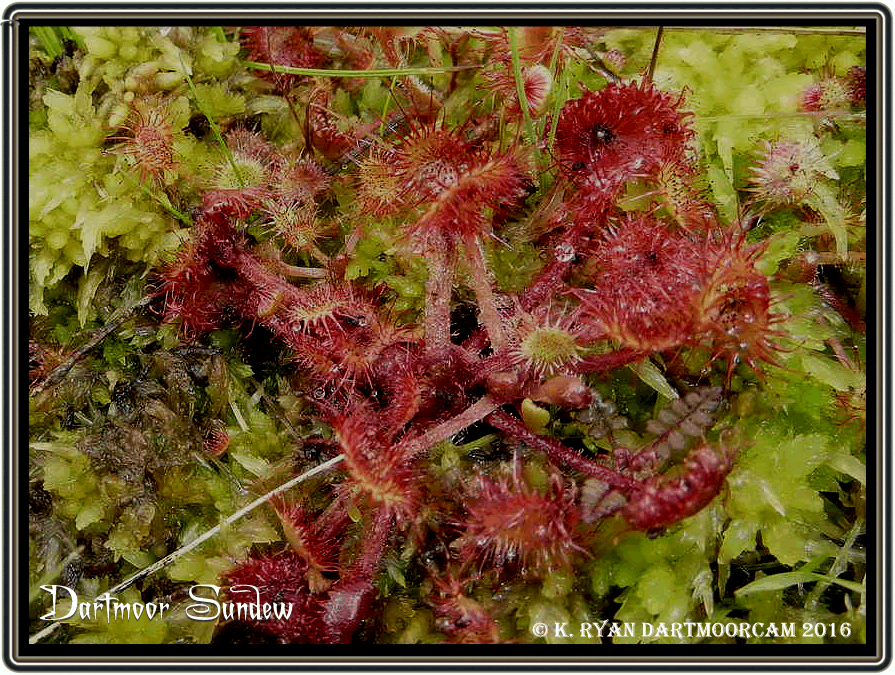
“By the lone fountain’s secret bed’
Where human footsteps rarely tread,
‘Mid the wild moor of silent glen,
The sundew blooms unseen by men;
Spreads there her leaf of rosy bloom,
A chalice for the morning dew,
And, ere the summers sun can rise,
Drinks the pure waters of the skies.”
To the round-leafed sundew – Anon 1844.
Ever been sploshing through a Dartmoor bog and suddenly your foot sinks without warning then as you look down to see the damage a patch of sundews lay at your feet? For me this sight tends to pleasantly distract from the foul smelling liquid seeping into your boots and soaking your socks. Likewise on a hot day the flies are constantly buzzing around your face causing much annoyance when you suddenly spot some sundews with a few hapless flies being slowly dissolved in their ‘honey trap’ – justice is served.
Drosera rotundifolia is the official Latin name for the round-leafed sundew which are familiar residents of Dartmoor’s valley mires and blanket bogs. The name sundew stems from the fact that the ‘dew drops’ are only seen in the Summer which is naturally associated with a hot sun and therefore became known as ‘sundew’. In some districts of the moor the sundew was also known as the ‘Red Rot’, presumably because of its colour and the fact that rotting insects could be seen on it. But there are other close relatives of this plant which can be found on Dartmoor, namely the oblonged-leafed sundew (Drosera intermedia)and the great or English sundew (Drosera anglica) which is the rarest of the family. They can be found living amongst carpets of sphagnum mosses which means vital nutrients for the plant are scarce. This plant demonstrates nature’s way of providing a means for survival in what normally could be regarded as a hostile environment. Because the Dartmoor soils are very low in the much needed nutrients the sundew needs to thrive this shortfall has been compensated by the ability to catch and digest insects which provide the missing nutrients. On each of its highly visible red leaves are minute hair-like tendrils at the end of which sits tiny, shiny droplets of sweet nectar. These droplets or ‘dew’ are incredibly sticky and so when an insect comes to feast on the nectar the plant thinks; “welcome to my parlour,” and begins to close its tendrils. Eventually, over a period of about 20 minutes the leaves will have completely engulfed the hapless insect and then a slow process of digested begins thus kindly donating its nutrients to the plant. Once the colder weather comes the sundew will produce what is known as a hibernaculum which is basically a bud of tightly curled leaves which insulates the dormant plant until the warmer weather arrives. It is estimated that each of the sundew’s ‘traps’ live long enough to ingest insects 2 to 4 times before dying. There is a current study taking place which is looking at ‘refugia’ which basically are areas which act as new homes for species that are forced to migrate due to climate change. Dartmoor is known to be one of the top refugia locations for the sundew plant.
The ‘juice’ of the sundew is very bitter to the taste and on some farms it was used as a substitute for rennet in order to curdle the milk when making cheese. Ever since the iron Age people have been using the plant as a hair dye. If the whole plant is mixed with ammonia (and you can guess where that came from in those days) it will produce a livid yellow dye and similarly the roots were used for a purple dye.
There were/are those folk who believe that a small piece of the plant secretly hidden in a persons clothing will act as a powerful love potion. The theory behind this was that if the plant was capable of ‘trapping’ an insect then it just may pass on some of its abilities to ‘ensnare’ a prospective partner?
The thing that always amazes me is how did we humans first come across the notion that a sundew plant contained varies healing properties? I can understand with some plants that look edible somebody coming along and eating such then discovering it had some curative powers. But who on earth was traipsing through a bog, spotting a triffid-like plant with dead insects stuck all over it and then thinking; “Ooo, I wonder what miracles that will perform,” and then begin to try tasting the various elements such as the leaves and juices? Anyway, somebody must have done so for centuries the sundew has been used for various herbal cures. One such being a restorative called ‘Rosa Solis’ or ‘Dew of the Sun’ and with a name like that I’m sure it would make a fortune today. Other early herbalists have said sundew in various forms and applications will cure whooping cough when mixed with asses milk, consumption, and according to Culpepper, ‘qualms and passions of the heart’. In some instances when the correct amount of the plant was mixed with milk ladies would use it to alleviate sunburn and remove freckles.
In some respects these early herbalists were correct without scientifically knowing it for the plant contains anthraquinones which are anti-microbial and anti-spasmodic agents and are still prescribed by modern herbalists for whooping cough, bronchitis, general chest coughs and asthma today. In its purest form the plant has been known to be active against Streptococcus, Staphylococcus, and Pneumococcus which could be an answer to the antimicrobial resistance problem of today? Some will say that the juice of the plant will also remove warts and corns when applied over a period of a week.

There are numerous locations on Dartmoor where you can find sundews both on the high open moors and around the lower levels in some cases where you would least expect to find them. One very accessible location is the Wildlife Trust’s 99 hectare Emsworthy Mires Reserve close to Saddle Tor. Nearby to Emsworthy is the of which Trendlebeare Down is another spot where sundews thrive.

The nominated grid square in Dartmoor 365 for the sundew is M17 however it can be found in many others across Dartmoor.
 Legendary Dartmoor The many aspects past and present of Dartmoor
Legendary Dartmoor The many aspects past and present of Dartmoor
